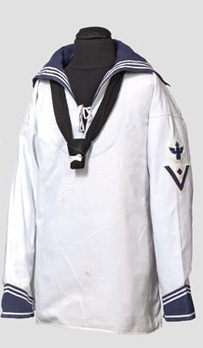Afrikakorps Kriegsmarine White Jumper Shirt
CATEGORY: Version
SKU: 23.GOR.02.01.02.02.001.000
Estimated market value:

Estimated market value:
During the Second World War, German troops stationed in northern Africa are generally referred to as the Afrikakorps. Technically, this is not entirely correct, since some German units operating in Africa were not actually part of the DAK (Deutsches Afrikakorps), and some units of it were, in fact, Italian ones. However, for the purpose of collecting so-called “tropical” uniforms and insignia, collectors have simplified the meaning of the term.
The first German troops were sent to northern Africa in February of 1941, to support their Italian allies against the British. The climate of the African continent made it necessary to wear specialised uniforms and gear that not only supported the soldiers in serving in a hot and arid environment, but also helped them in blending in with the landscape, which, in general, presented itself as brown, olive, khaki, or sand/tan in colour. Worn over long periods of time under the blistering desert sun, some uniforms were eventually bleached to white or off-white. Uniforms and insignia in these colours are often referred to as “tropical”, and it is worth noting that they weren’t just worn by members of units stationed in Africa, but in the entire Mediterranean theatre of war, including southern France, Italy, the Balkans, and Greece, as well as in southern Russia during the summer months. Tropical uniforms were worn by members of all three branches of the Wehrmacht: the Heer (army), the Kriegsmarine (navy), and the Luftwaffe (air force). Members of the Waffen-SS stationed in southerly regions also wore tropical-style uniforms, and even though they technically have no connection to the DAK, all tropical uniforms and insignia of all branches of the German military are listed here.
The Kriegsmarine had three different tropical dresses: the white dress, the pre-war brown dress (which was very rarely worn), and the wartime brown/khaki dress, which was introduced in late 1941. The pre-war brown dress is identical to the white dress, but made of brown drill fabric.
The Jumper Shirts were worn by Kriegsmarine Privates and Junior Non-Commissioned Officers. These shirts were produced in a blue version and a white version. The blue jumper shirts were worn while performing duties on ships, or at land-units and command centres, while the white jumper shirts were permitted for wear while performing duties during summer months, in tropical locales, and when the personnel was on leave.
The shirts were worn tucked into the trousers, but their total length extended to the wearer’s mid-thigh.
The shirts are composed of several main elements, including the shirt fabric, the shirt collar, the drill collar, the neckerchief, the breast slash and cords/ribbons, the pocket, the sleeve cuffs, the national emblem, and the rank and career insignia. The white jumpers are made of white cotton drill.
The shirt collars of these jumpers are rectangular and were sewn onto the neck. The white jumper shirt collars are composed of a layer of blue nankeen cloth that has three parallel white stripes.
The Exerzierkragen (drill collar/blue shirt collar) was only worn on top of the shirt collar of the white jumpers when explicitly ordered. These drill collars were secured via panels attached to the body of the wearer.
The neckerchief is made of black silk and worn in conjunction with the white jumper when it was donned as part of the tropical or walking-out dress.
Every jumper has a v-shaped slash down the centre of the shirt. This slash is lined in basic cloth for support and has a hidden buttoning tab that was used to close the slash during severe weather. Another option for closing the slash was the slash cords or ribbons. The ribbons on the white jumper are white, flat, and 300mm long. These devices are located on either side of the side of the slash and were generally worn tucked inside the jumper.
These jumpers also have a pocket positioned on the inside of the left breast. This pocket was made of blue nankeen cloth for the white jumper. It was used to hold the wearer’s identification documents, such as their pay book and I.D. card. This pocket is often erroneously called the “Knife Pocket”.
The white jumper sleeve cuffs have a slash along the sleeve seam. They have one button and are decorated with a panel of blue nankeen cloth.
The national emblem is featured on the right breast of the jumpers, and it is generally embroidered on a cloth backing that matches the colour of the jumper. When present, the career and rank insignia are situated on the left sleeve of the jumpers.
The Jumper Shirt is also known as a Pullover.

Comments
Sign in to comment and reply.


Scroll Top